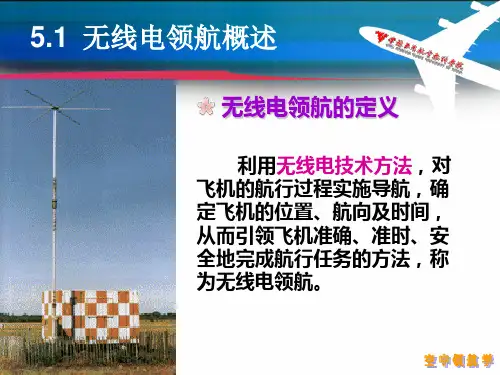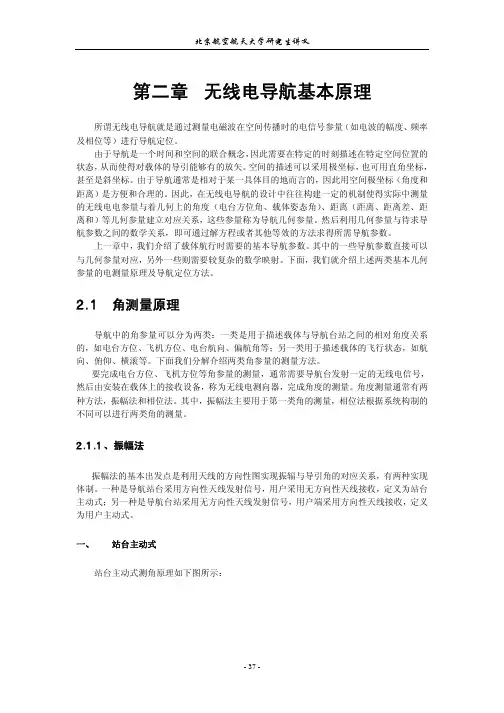无线电导航原理和机载设备简介(Principles of radio navigation and airborne equipment)
- 格式:doc
- 大小:38.50 KB
- 文档页数:10

★NDB使用方法及举例--澳门飞香港★从澳门国际机场飞往香港启德机场,练习沿指定航向飞向NDB、用IGS 进近、目视转弯着陆。
请先参阅前文《无线电导航原理和机载设备简介》,了解NDB的信号特点、座舱中的方位角指示器(ADF表头)的组成和航电设备控制面板上的接收频率设置。
NDB的使用比VOR简单得多,接收到信号时无论飞机怎样转向,ADF指针都会指向NDB发射台所在方位,就象指南针总是指向磁北极一样。
表头上的刻度盘是用来读取角度差的,与信号接收无关,一般不必旋转这个刻度盘。
一、飞行计划(Flight Plan)二、资料准备查阅下面的启德机场13跑道进近航线图,了解有关信息:跑道(磁)航向为135度,而进近航向为88度,IGS跑道,与一般的ILS跑道的差别在于进近的末段要向右作47度(135-88=47)的目视转弯才能对准跑道中心线。
这就是启德机场“举世闻名”的直接原因。
IGS频率为111.9。
跑道接地区海拔标高为15英尺,ATIS频率为128.2,用COM收听可得知场压(这里通常是29.91),以校正高度表。
沙螺湾NDB(SHA LO WAN,SL)在88度最后进近航线(Final Approch)的南面,从下面的进近航线剖面图可见,切入进近航线的方法是:在4500英尺高度上通过沙螺湾NDB,以45度磁航向进入。
正常的进近航线是应从长洲VOR(CHEUNG CHAU,CH)、在6000英尺高度上开始的。
这次我们为了练习使用NDB,从沙螺湾开始飞进近航线。
三、飞行过程空中飞行过程包括:起飞离场,左转飞向沙螺湾NDB,同时爬升到巡航高度4500英尺,之后增速至120节,通过沙螺湾后,以45度航向切入IGS进近航线,最后目视右转弯着陆。
选机型Cessna182S,按键Shift-数字8,然后Ctrl-Enter三次,调整前视角度。
在FS98选菜单/World / go to .../ Airport.../,在airport name...栏打入macau,将飞机的位置移到澳门国际机场的RWY16上。

无线电导航的原理与应用一、导言无线电导航是一种利用无线电信号进行定位和导航的技术。
它广泛应用于航空、航海、车载导航和无人机系统等领域。
了解无线电导航的原理与应用对于理解现代导航系统的工作方式至关重要。
本文将深入介绍无线电导航的原理和其在不同领域的应用。
二、无线电导航原理无线电导航是基于无线电波传播的定位和导航技术。
其原理基于以下几个关键要素:1. 信号发射器无线电导航的系统中,会有一个或多个信号发射器,常用的是卫星导航系统中的卫星。
信号发射器会发送特定频率的无线电波信号。
2. 接收器接收器负责接收信号发射器发出的无线电波信号,并将其转化为导航系统能够识别和处理的信息。
3. 测距原理无线电导航中常用的测距原理包括时间测距、多普勒效应和信号强度测距等。
这些原理可以通过接收到的信号特征来确定位置和距离。
4. 三角定位法利用多个信号发射器和接收器,可以采用三角定位法来确定准确的位置。
通过测量不同信号到达接收器的时间差和距离,可以计算出接收器的位置。
三、无线电导航的应用1. 航空导航航空领域是无线电导航最常见的应用之一。
航空导航系统利用全球定位系统(GPS)等技术,能够实时、准确地定位飞机的位置。
无线电导航在航空领域中的应用使得飞行变得更加安全和高效。
2. 航海导航航海导航依赖于无线电导航系统来确定船只的位置和航向。
借助GPS和其他卫星导航系统,船只可以在海上定位和导航,避免撞船和迷航等危险情况。
3. 车载导航车载导航系统利用无线电导航原理来为驾驶员提供路线指引和实时导航。
通过全球定位系统和地图数据,驾驶员可以更好地规划行驶路线并避开交通拥堵。
4. 无人机导航无人机的导航是依赖于无线电导航技术实现的。
无人机可以利用GPS等定位系统精确导航,实现自主飞行和遥控飞行。
5. 军事应用无线电导航在军事领域也有广泛的应用。
军事导航系统能够为士兵和战机提供准确的定位和导航信息,提升军事行动的效率。
结论无线电导航作为一种基于无线电信号的定位和导航技术,广泛应用于航空、航海、车载导航和无人机等领域。


无线电导航设备与系统概述无线电导航是借助于载体上的电子设备接收和处理无线电波在空间传播时的无线电信号参量(如幅度、频率及相位等)获得载体相对导航台的导航参量(如方位、距离、速度等),从而获取载体的实时位置信息,以保障载体安全、准确、及时地到达目的地的一种导航手段。
无线电导航具有不受时间、天气的限制;精度高;定位时间短;设备简单、可靠等优点。
无线电导航的主要缺点在于它必须辐射和接收无线电波因而易被发现和干扰,且绝大多数无线电导航设备需要载体外的导航台支持工作,一旦导航台失效,将使与之相应的无线电导航设备在此期间无法使用。
航空导航系统所必备●确定所产生的信号特性的方法;●带有天线的发射机,用来产生和发射无线电波;●飞机接收设备和天线,用来截获信号并对接收到的信号进行选择和译码;●为驾驶员提供的适当的视觉显示装置,用来对接收到的信号进行适当的评价。
导航参量●用于描述载体的航行状态●载体航行状态指的是载体作为一个刚体在空间运动时所表现的物理状态,通常与一定的参照系(如载体坐标系、当地地理坐标系等)相联系,它们可以从不同的角度来进行描述,如方位、距离、位置、速度、姿态等,而狭义的航行状态通常仅仅局限于速度和姿态的描述。
●方位:以经线北端为基准,顺时针测量到水平面上某方向线的角度。
●相对方位:以飞机纵轴的前端与观测线在水平面上的夹角来表示目标的方向。
方位相对方位基本原理在二维或三维空间中,若导航台的位置已知,相对于该位置的某一导航参量相同的点的轨迹应为一条曲线或一个曲面,该曲线或曲面称为位置线或位置面;单值确定载体的位置,至少需要测定两条位置线(在二维空间内)或三个位置面(在三维空间内),根据相交定位法实现定位。
位置线(a)圆位置线;(b)直线位置线;(c) 等高线;(d)双曲线位置线相交定位 位置线定位原理☐ 如果通过无线电方式测量到了三个独立的几何参量,则可以得到,三个独立的位置面方程:⎪⎩⎪⎨⎧===),,(),,(),,(332111z y x f u z y x f u z y x f u☐ 因而可以得到载体在空间中的三维位置。



导航工程技术专业学习教程无线电导航原理与技术导航工程技术专业学习教程:无线电导航原理与技术无线电导航是现代导航系统中的重要组成部分,它利用无线电信号来确定目标位置和导航航行的技术。
本文将介绍无线电导航的原理及相关技术。
一、无线电导航原理无线电导航的原理基于无线电信号的传播和接收。
导航系统通过测量无线电信号的时间、频率和幅度等参数,来判断接收器与发射器之间的距离和方向,从而实现目标的定位和导航。
1. 无线电信号传播无线电信号在空间中传播时会受到衰减和干扰。
衰减是指信号在传播过程中损失能量,其程度与距离和介质特性有关。
干扰是指其他无线电信号或物体对信号传播造成的影响。
了解信号传播的特性对于设计和优化导航系统至关重要。
2. 接收信号处理导航系统的接收器通过接收信号并进行处理来获取目标的位置和导航信息。
接收信号处理的关键是信号的解调和解调。
解调是指恢复信号的调制特性,包括频率、幅度和相位等。
解调则是指从解调信号中提取目标信息,例如距离、速度和方向等。
二、无线电导航技术无线电导航技术应用广泛,包括卫星导航系统、无线电信标和无线电方位器等。
1. 卫星导航系统卫星导航系统是利用卫星发射无线电信号,通过接收卫星信号来确定目标位置和导航。
全球定位系统(GPS)是最常用的卫星导航系统之一,它由多颗卫星组成,可提供全球覆盖的导航服务。
其他卫星导航系统还包括伽利略导航系统和北斗导航系统等。
2. 无线电信标无线电信标是一种用于导航的无线电设备,它发射特定的无线电信号,标记着特定的位置。
航空器和船舶等可以通过接收和识别无线电信标的信号,来确定自身的位置和导航航行。
无线电信标的种类有很多,例如雷达信标、无线电信号灯和无线电浮标等。
3. 无线电方位器无线电方位器是一种利用无线电信号进行方位测量的设备,常用于航空和海洋导航中。
通过测量接收到的信号到达时间差异和信号强度,无线电方位器可以确定目标相对于其位置的角度和方向。
无线电方位器的应用包括无线电导航台和无线电方位查找器等。



第二章 无线电导航基本原理所谓无线电导航就是通过测量电磁波在空间传播时的电信号参量(如电波的幅度、频率及相位等)进行导航定位。
由于导航是一个时间和空间的联合概念,因此需要在特定的时刻描述在特定空间位置的状态,从而使得对载体的导引能够有的放矢。
空间的描述可以采用极坐标,也可用直角坐标,甚至是斜坐标。
由于导航通常是相对于某一具体目的地而言的,因此用空间极坐标(角度和距离)是方便和合理的。
因此,在无线电导航的设计中往往构建一定的机制使得实际中测量的无线电电参量与着几何上的角度(电台方位角、载体姿态角)、距离(距离、距离差、距离和)等几何参量建立对应关系,这些参量称为导航几何参量。
然后利用几何参量与待求导航参数之间的数学关系,即可通过解方程或者其他等效的方法求得所需导航参数。
上一章中,我们介绍了载体航行时需要的基本导航参数。
其中的一些导航参数直接可以与几何参量对应,另外一些则需要较复杂的数学映射。
下面,我们就介绍上述两类基本几何参量的电测量原理及导航定位方法。
2.1 角测量原理导航中的角参量可以分为两类:一类是用于描述载体与导航台站之间的相对角度关系的,如电台方位、飞机方位、电台航向、偏航角等;另一类用于描述载体的飞行状态,如航向、俯仰、横滚等。
下面我们分解介绍两类角参量的测量方法。
要完成电台方位、飞机方位等角参量的测量,通常需要导航台发射一定的无线电信号,然后由安装在载体上的接收设备,称为无线电测向器,完成角度的测量。
角度测量通常有两种方法,振幅法和相位法。
其中,振幅法主要用于第一类角的测量,相位法根据系统构制的不同可以进行两类角的测量。
2.1.1、振幅法振幅法的基本出发点是利用天线的方向性图实现振辐与导引角的对应关系,有两种实现体制。
一种是导航站台采用方向性天线发射信号,用户采用无方向性天线接收,定义为站台主动式;另一种是导航台站采用无方向性天线发射信号,用户端采用方向性天线接收,定义为用户主动式。

飞机导航原理
飞机导航是指飞行器确定自身位置、航路和目标的过程。
导航系统通过使用各种技术和设备,包括地面导航站、无线电导航设备、惯导系统和卫星导航系统,来帮助飞行员准确地导航。
地面导航站是位于地面上的设施,用于发送无线电信号以帮助飞机确定自身位置和航向。
其中最常用的地面导航设备是非方向性无线电信标(NDB)和全向信标(VOR)。
非方向性无线电信标发送无干扰信号,飞机通过接收信号来确定自身距离信标的距离。
全向信标则发送带有方向信息的信号,飞机可以通过接收该信号来确定自身相对于信标的方向。
无线电导航设备是飞机上的导航设备,用于确定自身位置和航向。
最常见的无线电导航设备包括自动导航系统(INS)和惯性导航系统(IRS)。
这些系统使用陀螺仪和加速度计等惯性传感器来检测飞机的运动,并根据已知的起始位置和方向计算当前位置和航向。
卫星导航系统是一种使用卫星信号来确定位置和航向的导航系统。
其中最著名的卫星导航系统是全球定位系统(GPS)。
GPS系统使用一组卫星定位导航接收机的位置,并通过卫星信号来计算接收机的位置和航向。
飞机导航的原理是通过使用以上的技术和设备,将飞机的位置和航向信息传递给飞行员,以确保飞机沿着预定的航线安全地导航。
飞行员可以根据导航系统提供的信息进行航向调整和航路规划,以达到目标地点。
需要注意的是,飞机导航系统的精度和可靠性对于飞行安全至关重要。
因此,飞行员必须定期检查和校准导航设备,以确保其正常运行。
此外,飞行员还需要时刻关注导航设备的指示和警告信息,以及接收来自地面导航站的任何导航更新或通知。
无线电导航原理无线电导航呢,就像是有一群超级小的小精灵在空中飞舞着给你指路。
这些小精灵其实就是无线电波啦。
你知道吗,无线电波这东西可神奇了,它能在空气中到处跑,就像调皮的小娃娃在大街小巷乱窜。
我们先来说说最基本的一种无线电导航设备——无方向信标(NDB)。
这个NDB就像是一个超级大喇叭,一直在喊:“我在这儿呢,我在这儿呢!”它不停地向四周发射无线电波。
那飞机或者轮船上面的接收设备呢,就像一个超级灵敏的小耳朵,听到这个声音之后,就能知道这个“大喇叭”在哪个方向啦。
比如说,你在一片大雾的森林里迷路了,突然听到有个人在一个方向大喊,你是不是就大概能知道往哪边走啦?这NDB就是这么个道理。
然后呀,还有甚高频全向信标(VOR)。
这个VOR就更高级一点啦,它就像是一个会发光的灯塔,不过这个光不是我们肉眼能看到的光,而是无线电波组成的“光”。
它发射出的电波就像一圈一圈的光环一样,每个光环都代表着不同的方向。
飞机或者船上的设备接收到这些电波之后,就能精确地知道自己相对于这个VOR台的方向啦。
这就好比你在一个大圆盘中间,圆盘上有很多彩色的线条,你只要看自己站在哪个线条的方向上,就知道自己该往哪走了。
再来说说测距仪(DME)。
这东西就像是一把超级精确的尺子。
它是怎么量距离的呢?它也是通过无线电波来工作的。
飞机或者船向DME台发射一个信号,然后这个台再回一个信号,就像两个人互相扔球一样。
通过计算这个信号来回的时间,就能算出两者之间的距离啦。
你想啊,你大喊一声,然后听到回声,如果你知道声音传播的速度,是不是就能算出你和那个反射声音的东西之间的距离呢?这DME就是这么聪明。
全球定位系统(GPS)那可就是无线电导航里的超级明星啦。
GPS就像天上有好多好多小眼睛在看着你。
这些小眼睛就是卫星啦。
卫星不停地向地球发射无线电信号,然后你的GPS接收设备就接收这些信号。
通过接收好多颗卫星的信号,就能算出自己在地球上的位置,精确到很小很小的范围呢。
无线电导航原理和机载设备简介导航概述早期的飞行器在空中飞行仅依靠地标导航--飞行中盯着公路、铁路、河流等线状地标;山峰、灯塔、公路交汇点等点状地标;湖泊、城镇等面状地标。
后来,空勤人员利用航空地图、磁罗盘、计算尺、时钟等工具和他们的天文、地理、数学知识,根据风速、风向计算航线角,结合地标修正航线偏差,这种工作叫做“空中领航”。
这种方法虽然“原始”,但航空先驱林伯当年就是依靠这些东西驾驶一架活塞式单发动机飞机“圣路易斯精神号”独自由美国西海岸起程,直接飞越大西洋到达巴黎的,他飞越茫茫大西洋时还通过观察海上的洋流、夜空中的星座来辨别方向、确定位置。
空中领航学是飞行员的一门必修课,其核心是用矢量合成原理修正风对飞行航迹的影响。
随着无线电技术的发展,各式各样的电子设备为飞行器提供精确的导航信息:有用于洲际导航的奥米加导航系统(OMEGA)、适用于广阔海面的罗兰系统(LORAN-A,LORAN-C)、用于近距导航的甚高频全向无线电信标导航系统(VORTAC),另外还有一些专为军事用途开发的导航信标和雷达系统。
现在,利用同步卫星工作的全球定位系统(GPS)已开始广泛使用。
但VORTAC 仍是近距导航的主流,绝大多数现代军民用飞机,包括民航客机、小型通用飞机都配备有VOR接收机(VOR,very high frequency ommi-directional range)。
VORTAC是VOR/DME和TACAN的统称。
VOR/DME是民用系统,TACAN是为适应舰载、移动台站而开发的军用战术空中导航系统(即塔康导航系统)。
两者的工作原理和技术规范都不同,但使用上它们是完全一样的。
事实上,有的VOR/DME和TACAN发射台站是建在一起、使用同一个频率的,对空勤人员来说,只是一个VOR信标。
VOR信标是世界上最多、最主要的无线电导航点。
许许多多的VOR台站相隔一定距离成网络状散点分布,当飞机上的接收机收到VOR信标的信号,飞行人员就可通过专用仪表判断飞机与该发射台站的相对位置,如果台站信号是带测距的(DME,distance measuring equitment),还可知道飞机与台站的距离,从而确定飞机当前的位置,并知道应以多少度的航线角飞抵目的地。
无线电导航的原理Wireless radio navigation is a method of using radio waves to determine the position of an object or person. 无线电导航是一种利用无线电波来确定物体或人的位置的方法。
This technology is widely used in various fields, from aviation to maritime navigation, and is an essential tool for maintaining accurate and reliable positioning. 这项技术被广泛应用于各个领域,从航空到海上导航,是保持准确可靠定位的重要工具。
The principle of wireless radio navigation is based on the transmission and reception of radio signals between a ground-based or satellite-based transmitter and a receiver on the object or person being navigated. 无线电导航的原理是基于地面或卫星发射器与被导航对象或人员的接收器之间的无线电信号的传输和接收。
The transmitter emits a radio signal with specific characteristics, such as frequency, modulation, and encoding, which allows the receiver to determine its own position relative to the transmitter. 发射器发射具有特定特征的无线电信号,例如频率、调制和编码,这使接收器能够确定自己相对于发射器的位置。
无线电导航原理与系统无线电导航是一种通过使用无线电技术来确定位置和导航的方法。
它通过接收和处理从地面或者卫星发射的信号来确定接收器的位置和方向。
无线电导航系统的原理涉及到以下几个方面。
首先,无线电导航依赖于距离和方向的测量。
无线电导航系统通常使用三角测量原理来确定位置。
接收器同时接收到至少三个信号,并测量每一个信号到达接收器的时间差。
通过测量这些时间差,接收器可以计算出到每个信号源的距离。
而通过将这些距离和信号源的位置进行三角测量,接收器可以得出自身的位置。
其次,无线电导航还依赖于卫星。
全球定位系统(GPS)是无线电导航系统中应用最广泛的卫星导航系统之一。
GPS系统由多颗卫星组成,这些卫星都在地球轨道上运行。
接收器接收到这些卫星发射的信号,并使用这些信号来计算出自己的位置。
通过接收到多颗卫星的信号,接收器可以通过三角测量计算出自身的位置。
此外,无线电导航还涉及到信号处理和解调。
当接收器接收到从地面或卫星发射的信号时,它需要将这些信号进行处理和解调,以便得到有用的信息。
信号处理涉及到去除噪音、增强信号等操作,以保证接收到的信号的质量。
解调则是将信号转化为数字信息,从而可以进行位置和导航计算。
最后,无线电导航还依赖于地面设备。
除了卫星之外,无线电导航系统还依赖于地面设备,如基站和测量站。
这些设备用来发射信号,并与接收器进行通信。
地面设备的准确性和稳定性直接影响到无线电导航系统的精确度和可靠性。
综上所述,无线电导航系统的原理涉及到距离和方向的测量、卫星导航、信号处理和解调以及地面设备。
通过利用这些原理,无线电导航系统能够准确地确定位置和导航。
无线电导航在航空、航海、军事等领域有着广泛的应用,为人们的出行和导航提供了重要的帮助。
无线电导航原理和机载设备简介(Principles of radio navigationand airborne equipment)Principles of radio navigation and airborne equipmentEarly aircraft flying in the air relied solely on landmark navigation - the linear landmarks that looked at roads, railways, rivers, etc.; landmarks such as peaks, lighthouses, road interchanges, etc.; landmarks such as lakes and towns. Later, aviation map, compass, slipstick, clock and other tools and their astronomy, geography, mathematics knowledge by aircrew, according to the wind speed and wind direction calculation route angle, combined with landmark fix route deviation, this work is called "air navigation". This method is the "original", but Lin Bo aviation pioneer is to rely on these things when driving a single engine piston aircraft "spirit of Saint Louis" alone from the west coast of the United States set out directly over the Atlantic arrived in Paris, he flew over the vast the Atlantic is through observation of the sea currents, the night sky in the constellation to identify the direction determine the position. Air navigation is a required course for pilots. The key is to modify the influence of wind on flight path by using the principle of vector composition.With the development of radio technology, every kind of electronic equipment provide accurate navigation information for aircraft: for the Omega Navigation System (OMEGA), intercontinental navigation Loran system suitable for a wide sea level (LORAN-A, LORAN-C), for VHF omnidirectional radio short-range navigation standard navigation system (VORTAC),and some for the military development of navigational beacons and radar system. Now, the global positioning system (GPS), which uses geostationary satellites, has begun to be widely used. But VORTAC is still the mainstream of short-range navigation, and most modern military and civilian aircraft, including civil aircraft and small general-purpose aircraft, are equipped with VOR receivers (VOR, very, high, frequency, ommi-directional, range).VORTAC is a general term for VOR/DME and TACAN. VOR/DME is a civilian system, TACAN is developed for shipborne mobile stations, military tactical air navigation system (i.e. the TACAN navigation system). Both work principles and technical specifications are different, but the use of them is exactly the same. In fact, some VOR/DME and TACAN transmitting stations is built together, using the same frequency, the aircrew, just a VOR beacon. VOR beacons are the most important and important radio navigation points in the world. Many of the VOR stations separated by a distance into a network like distribution, when the signal receiver on the aircraft received the VOR beacon, pilots can determine the relative position of the aircraft and the launch station through a special instrument, if the station signal is band ranging (DME, distance measuring equitment), and also know the plane and the station distance, so as to determine the current position of the aircraft, and to know the degree of the flight angle to fly to the destination.Fundamentals of VOR/DME/NDBVOR:very, high, frequency, ommi-directional, range, VHF omnidirectional radio beaconThe operating frequency of the VOR signal transmitter and receiver is between 108.0-117.95 and MHz. The VOR signal transmitted by the transmitter stations have two: one is the phase of the reference signal of the stationary phase; another signal is changing, at the same time as the lighthouse to rotate searchlights every 360 degrees and launch phase signal to launch various angles are different, and their reference signal the phase difference is naturally different. A signal to the 360 degree (pointing to the magnetic north pole) is in phase with the reference signal, while the signal to the 180 degree (pointing to the magnetic pole) is 180 degrees from the reference signal. The VOR receiver on the aircraft can determine the angle at which the aircraft is at the station, based on the phase difference between the two signals received. That is to say, it is possible to determine which radius of the aircraft is at the center of the station transmitter.The signals sent by VOR stations form 360 "radii" that radiate in all directions, each of which is called a "Radial"".If the plane is located in the flat state: VOR station (the station codenamed POU) the South East, toward the station to station, which changed over the course, to the southwest. Navigation terms: aircraft along the POU 135 Radial (R-135), (inbound) to the station, namely the magnetic heading of 315 degrees at POU, along the R-225, fly away from the station (outbound), namely the magnetic heading of 225 degrees. Note: when the plane along a Radial fly away from the station, which is the magnetic heading Radial number; but when the plane flew along a Radial station, the magnetic heading and the Radialnumber 180.Because the radio signal VOR and television broadcast, radio FM radio, is a straight line, the mountain will be obstructions such as, so even if the distance is very near, on the ground are rarely able to receive a VOR signal, usually to fly up to 2000-3000 from the ground feet to receive signals, fly higher, receiving the distance is far away. At 18000 feet (5486 meters), the maximum receiving distance of VOR is about 40 to 130 nautical miles (1 nautical miles =1.852 kilometers), depending on factors such as visual impairment and obstruction. Above 18000ft, the maximum receiving distance is about 130 nautical miles.DME:distance, measuring, equitment, ranging deviceAs mentioned earlier, some VOR stations with DME, DME in UHF band. But the aircrew ignore its frequency, as long as a good tune the frequency of VOR, the signal is received, after a while, the distance calculated numbers will be displayed on the dashboard. Simple working principle is this: Airborne DME transmitting signals to the ground station on the DME, and receives the DME response back ground signal, measuring the transmitted signal and should sign signal time difference, half the time difference, can be calculated distance between aircraft and ground stations. However, it should be noted that the distance shown on the instrument panel is the distance from the slope of the aircraft to the ground station, and the unit is nautical mile. By the Pythagorean theorem, the plane projection and the ground station in the distance should be slightly less than the distance from the edge. Similarly, DMEdisplay on the dashboard of speed is "oblique", said the plane and station "distance shortening rate", is a unit of festival, it is not equal to the speed, is not equal to the speed. According to the DME display range and speed, can roughly estimate the aircraft ground speed and the time required to reach the station.NDB:non-directional beacon, NDB, or "radiophare"NDB is the oldest electronic navigation device still in use today, with inexpensive Chang Jianyou stations near NDB, where there is no instrument landing system, used as navigation and landing guidance. The name "non directional" means that the signals transmitted by each station in the same direction are not the same as each other in VOR. The NDB signal receiver on the aircraft is called ADF (automatic, direction, finder, azimuth indicator). The instrument head of ADF has only one pointer, and when the NDB signal is received, the pointer of ADF points to the direction in which the NDB station is located. If the plane flew straight toward the station, pointer is pointing to the front, when the plane flew over the station and continue to fly forward, the pointer will turn 180 degrees toward the rear.Introduction of airborne electronic navigation equipmentHere is the first clear look at: VOR and NDB are respectively the ground stations, transmitting VOR signal and NDB signal to the plane Nav1, Nav2 and ADF receiver in FS98, Cessna182S or Shift-2 button fly below Mouse click on the dashboard "avionics master switch control panel you can see these receivers (alsosee airborne DME, automatic control panel driving equipment).The three receivers, Nav1, Nav2 and ADF, have a circular instrument head mounted on the right side of the aircraft's main dashboard, in addition to the control panel, indicating specific navigation information.The instrument heads connected to the Nav1 and Nav2 receivers are called OBI, OBI1 and OBI2, respectively. The airborne DME also connects to a rectangular digital header,Install on top of these three round heads.COM1 and Nav1 panelsCOM1: VHF radio station, frequency range 118.0-136.975MHz.Nav1: can receive VOR signal and complete ILS signal, frequency range 108.0-117.95MHz.Nav2 panelNav2 is only used to receive VOR signals. Click the number with Mouse to change the reception frequency.ADF panelReceive NDB signal, frequency range 200-400KHzAirborne DME panelThe number on the left is the calculated distance and speed. The R1/R2 switch on the right is used to toggle the DME calculations that show Nav1 and Nav2.Responder panel (transponder)Receive air traffic control radar signals, and respond to the launch of four bit digital signals to air traffic control radar, allowing air traffic controllers to see the plane's position on the radar, or even height.Autopilot control panel (autopilot)DME headerDisplays distance, speed, and time to the selected VOR station from left to right, with Nav1, Nav2 display switches below.OBI2The Omni-Bearing Indicator, the instrument connected to the Nav2 receiver, displays the VOR information.OBS knobOmni-Bearing Selector, so that the dials rotate to select the line (Radial)CDI pointerCourse, Deviation, Indicator, line deviation indicator,indicating the current position of the aircraft on the selected route (Radial) of the OBS, leaning to the left or leaning to the right.To/From/Off signThe triangle represents the To upward; the triangle down indicates From; the red white bar indicates that Off-- has not received the selected Radial signal of the OBSOBI1Omni-Bearing Indicator, the instrument connected with the Nav1 receiver, besides the function of OBI2, it also shows the horizontal and vertical position information of the approach landing of instrument landing system (ILS).GS signThe To/From/Off flag moves below. The GS flag is added to indicate whether or not the ILS (Glide Slope) signal is received. The red and white bars indicate that the signal cannot be received. At this point, the slide indicator is not activated and does not work.Glide slope pointerIndicates the deviation between the current height of the aircraft and the required height of the ILS slipway.ADFThe Automatic, Direction, Finder, and header connected to the NDB receiver are called "azimuth indicators"".After receiving the signal, the pointer points directly to the location of the station.The knob and dial are purely mechanical auxiliary display devices, independent of pointer pointing and signal reception.The function of the knob and dial is to indicate the degree of difference between the heading to be taken from the station and the current course of the aircraft. The chart shows, stations in the left front of the aircraft, the deviation angle between 20-25 degrees.Sum up:1 and VOR are ground-based transmitting stations, and Nav is an airborne receiver.2, receiver Nav has control panel, press Shift-2 to open is the control panel, in the above can adjust the Nav receiving frequency.3, receiver Nav and instrument head, called OBI, it is installed on the main dashboard of the aircraft to the right, showing specific navigation information.4, the whole OBI (instrument head) consists of four parts: CDI pointer, To/From/Off mark, OBS knob, dial.5, the instrument head OBI1 connected by Nav1 itself can indicate the VOR information (same as OBI2).6, in order to indicate the ILS information of the instrument landing system, OBI1 has more than one GS sign and a glide path pointer over the OBI2. The GS flag indicates whether to receive the signal, the glide slope pointer, and the CDI two pointers, respectively, indicating the horizontal and vertical position information of the ILS.The next article begins with a detailed description of how to navigate and land using VOR/DME, NDB, ILS signals, and airborne electronic devices. But first we must understand the principles mentioned above and memorize the concepts and their abbreviations.Redstar (CFSO002)。